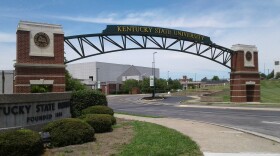FRANKFORT — Kentucky State University requested $50 million this year to build a nursing school for its growing class of future health care providers.
The legislature ultimately rejected the request, even though Kentucky enjoys a record-high revenue surplus and suffers from a shortage of nurses.
“The real tragedy is that we had the money to do it,” Rep. George Brown Jr., a Lexington Democrat, told the Lantern last week. He called the omission “a travesty.”
Brown and other lawmakers said the decision is part of a long pattern of neglect and underinvestment in historically Black colleges and universities (HBCUs) — a disparity the Biden administration also has highlighted.
It’s “always been the history,” said House Democratic Floor Leader Derrick Graham, a KSU alum who urged Republican legislative leaders to fund the nursing building.
During House debate, Black lawmakers pointed out that Kentucky’s only public HBCU was being denied $50 million for a project they deem critical to its future, while $125 million was quickly found for Northern Kentucky University and the University of Kentucky to open a biomedical center in downtown Covington, where plans also call for NKU to move its law school.
The Senate added the Covington project to House Bill 1, which moves $2.7 billion from the Budget Reserve Trust Fund into one-time spending over the next two years. HB 1 includes other higher education projects: $60 million for a veterinary tech facility at Murray State University, $25 million for a UofL Health cancer center in Bullitt County and $22 million for a livestock innovation center at a University of Kentucky research farm.
“Kentucky State always seems to suffer and always has to wait,” Brown said March 29 on the House floor. “‘You have to wait your time; it’s not your time.’ … So the question is, when will it be Kentucky State’s time?”
‘Lucky’ to get what they’re getting, says Thayer

When budget negotiators met in a free conference committee on March 26, Graham asked why KSU’s “top priority” was not included in budget legislation. Graham represents Frankfort where KSU sits on a hill overlooking the capital city.
Sen. Chris McDaniel, chairman of the Senate budget committee, explained that KSU had revised its budget request by also asking for money to deal with failing infrastructure and other maintenance needs.
House Bill 6, the state budget bill, sets aside $60 million in bonding for “asset preservation,” described by McDaniel as “cleaning up campus.” House Bill 1 includes $5 million to design a Health Science Center for the nursing program but nothing to build it. McDaniel vowed “full intent” to pay for construction of KSU’s nursing building in the 2026 budget bill. McDaniel’s district includes Covington; he was instrumental in obtaining the $125 million for the downtown project involving NKU.
“We have a great deal of confidence in the new president of Kentucky State,” McDaniel said in the March 26 meeting. He was speaking of Koffi Akakpo, who became KSU’s 19th president last year on July 1. Before that, he was president of Bluegrass Community and Technical College.
HB 6 provides all the public higher ed institutions with asset preservation funding pools for renovation and maintenance of buildings and other infrastructure.
During the free conference committee meeting, Democratic Senate leaders Gerald Neal of Louisville and Reggie Thomas of Lexington said that expanding KSU’s nursing program, which has a waiting list, is critical to the school’s rebound from recent troubles. The construction delay will cost KSU new students and needed tuition revenue and disrupt Akakpo’s plan for the future, said Neal. Neal and Thomas urged the budget negotiations to reconsider.
Thomas suggested spending less on restoration and maintenance at KSU in this budget to free up $50 million over the next two years to design and build the nursing building.
Senate Republican Floor Leader Damon Thayer of Georgetown responded that KSU was “probably lucky that they get the taxpayer money that they have been getting and continue getting.”
“With the recent numbers and results that have come from K-State, I think we should be dubious moving forward,” he said, adding the “numbers have been pretty embarrassing.”
KSU has faced a series of controversies, including misused funds under a former administration and a 2023 warning from its accreditation body. In 2022, the legislature put KSU under a management improvement plan and provided $23 million to help it recover from a budget deficit.
Training today’s nurse for today’s medicine
In an interview with the Lantern last week, Akakpo said he is “grateful” for the $60 million in bonding but that it will “go quickly” as he tackles a list of maintenance needs.
The HVAC system, he said, is “not quite up to par,” the dorms are “in really bad shape,” sidewalks and entryways need fixing, and “leaky roofs” have caused damage that needs attention.
The $60 million does “not quite” cover these needs, he said. “But we will try the best we can.”
A new building for nursing students and money to address maintenance needs were “both equally crucial for us to move forward,” Akakpo told the Lantern.
Nursing students make up 24% of KSU’s enrollment at around 342 students and “it’s only going to grow,” said Akakpo. Nursing students now study in three different buildings across campus because there isn’t one single designated building large enough for them.
The Betty White Health Center, which is 53 years old, hosts administrative offices and the learning lab, while nursing students take classes in Bradford Hall, Carver Hall and Hathaway Hall.

“The building is needed because the building that is assigned to the nursing program is too small” and already full, Akakpo said.
“We’re using other buildings to accommodate but these are buildings that are for other programs,” he said. “It’s just making it a bit complicated to manage but we have no choice.”
“It may be an issue” in the future to recruit students without the proper space to educate them, Akakpo said. “But there is always a solution; … either we get it this round, or we’ll get it next round.”
Kentucky is thousands of nurses short of what it needs. The Kentucky Hospital Association says there is a shortage of 5,391 registered nurses (RNs) and licensed practical nurses (LPNs). And, the students going into nursing school aren’t enough to replace those retiring and leaving the workforce.
Rep. Pamela Stevenson, D-Louisville, told the Lantern she has many questions about how money was allocated and why some higher education programs get more funding than others. She wants to see more transparency around the process of spending taxpayer money, she told the Lantern.
“It’s the structure and the transparency of the process that I’m not sure all citizens have access to,” she said. “It worked against KSU this time. They’ve got to scramble and figure out what to do with their … nurses.”
“It matters a lot. The work is very, very hard to do … (it’s) grueling to become a nurse and you’ve got to have the facilities that are keeping up with the way they nurse today,” she said. “We’ve got to have a facility to train the ‘today’ nurse for today’s medicine if we want to attract people and get rid of this deficit that we have.”
‘Just one more slap in the face’
Brown said KSU’s backlog of maintenance needs stems from historic underinvestment, saying the historically Black university is “the redheaded stepchild, if you will” of Kentucky higher education.
The Biden administration last year documented roughly $12 billion in underfunding for HBCUs nationwide when compared with state funding of similar predominantly white institutions.
The study compared land-grant institutions created by Congress in the 19th century, first for white students and later for Black students. KSU and UK are Kentucky’s land-grant universities. In Kentucky the disparity in per student state funding from 1987 to 2020 was $172 million.

U.S. Secretary of Education Miguel Cardona and U.S. Secretary of Agriculture Thomas Vilsack sent letters to governors, including Kentucky’s, asking for states to take steps toward righting the “historical underinvestment.”
A September letter sent to Gov. Andy Beshear cited “unbalanced funding” and “ longstanding and ongoing underinvestment” as reasons KSU “has not been able to advance in ways that are on par with University of Kentucky.”
“Unequitable funding” of KSU, the letter said, put KSU $172,135,168 short of what it would have received in the last 30 years.
“These funds could have supported infrastructure and student services and would have better positioned the university to compete for research grants,” the letter stated. “Kentucky State University has been able to make remarkable strides and would be much stronger and better positioned to serve its students, your state, and the nation if made whole with respect to this funding gap.”
The budget Beshear introduced in December did not include money for the KSU nursing building. It did ask lawmakers to allocate about $1.2 million to KSU for nursing and social work scholarships in 2024-2026.
Stevenson said the legislature’s refusal to fund KSU’s nursing building this year amounts to “just one more slap in the face. It sends the message of ‘you’re never going to be good enough. You’re never going to get what you need to thrive.’”
When “we have treasure that we refuse to honor,” Stevenson said, it “creates a division across the commonwealth.”
Brown agrees. “How long,” he asked, “must Kentucky State be put on the back burner?”
Akakpo, speaking to the Lantern on Friday, stressed that he is confident in the legislature’s support for KSU, saying he’s “very grateful to our elected officials” and that “I know they care. They’re very supportive of me.”
Akakpo is focused on the immediate: getting campus repairs like the HVAC system tackled before next winter. He’s confident the support will come — if not in the final two days of this session on April 12 and 15, then the next budget cycle.
“Since KSU found itself in financial problems, (lawmakers) have been there, supporting,” he said. “I’m confident that support is going to continue.”
This story was originally published by the Kentucky Lantern.





